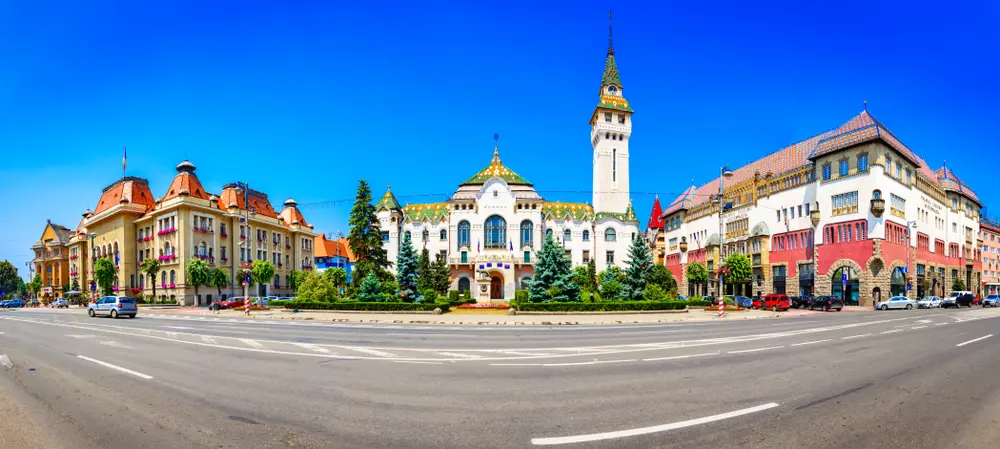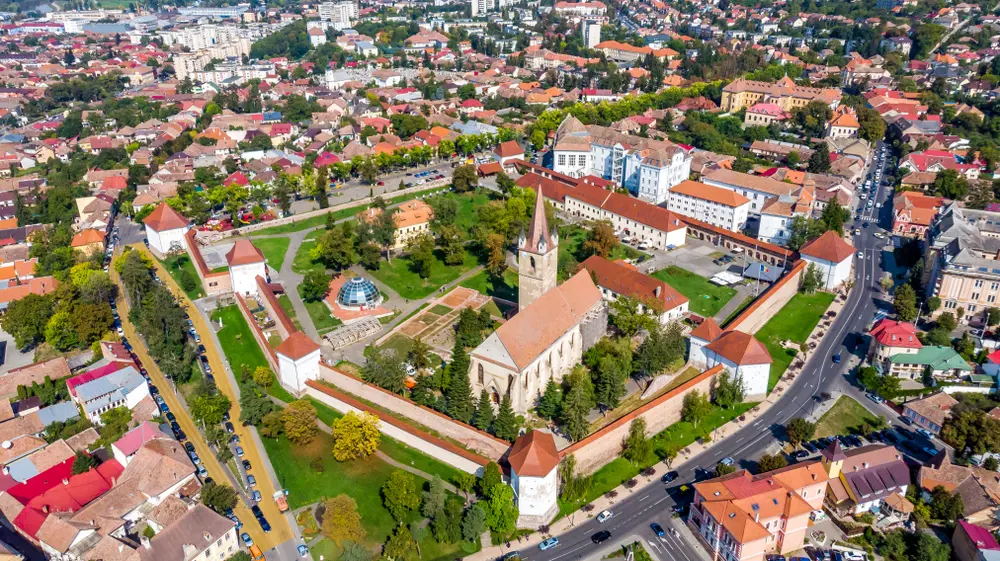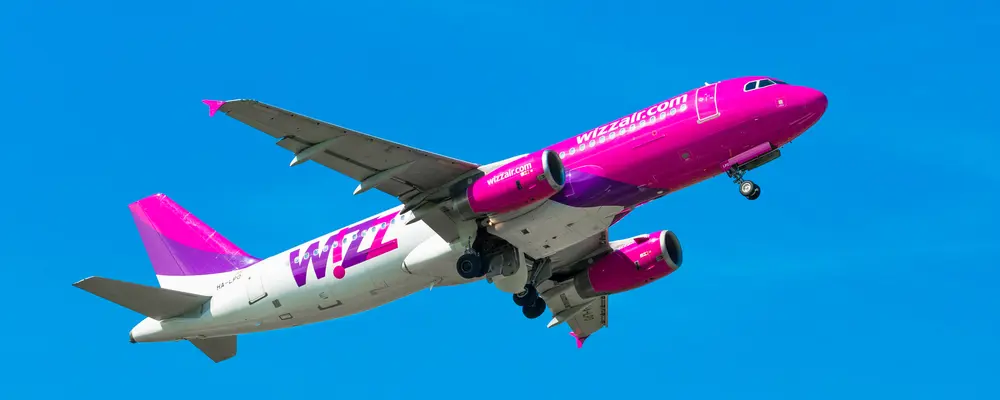The city of roses
Targu Mureș, known as “the city of roses“, is a city in Romania and chief town of the county of Mures in the historic region of Transylvania. It was once part of the Kingdom of Hungary and today 45% of the population are of Hungarian origin. The city, therefore, enjoys the best of both cultures: Romanian and Hungarian.

Tirgu Mures landscape

Square of the Roses with the equestrian statue and the Orthodox Church
Square of the Roses
Targu Mures became a modern city in the second half of the nineteenth century with the expansion of the railway line. Today, its centrally located Piata Trandafirilor (Square of the Roses) is much like that of any modern European city with cafeterias, restaurants, churches and monuments.
The main attraction of Targu Mures is located in the far south of the square: the Cultural Palace, a twentieth-century city hall with a stunning room decorated with stained glass windows, which houses some of the main local museums.

Administrative Palace and Palace of Culture
There are also many other tourist and cultural attractions to see. These include the Apollo Palace, built between 1820 and 1822, decorated in late Baroque style and restored in the twentieth century in Eclectic style, which today houses the Art School, and the Old PrefectureBuilding, in use since 1711 and currently the site of the workshops of several local artists.
Palffy House is the first example of Baroque architecture in the city, which dates back to the second half of the seventeenth century. It hosts the Music School of the University of Theatrical Arts of the city. The Teleki Library, founded at the end of the eighteenth century by Samuel Teleki, chancellor of Transylvania, contains editions of important manuscripts and documents the entire history of Transylvania.

The Medieval fortress seen from above
Built as a castle in 1492, the Fortress, in medieval military-type architecture, was restored between 1962 and 1965 and the wall and bastions were reclaimed with their initial form. There are various museums in the city that offer cultural and artistic ideas for a visit of certain interest, such as the Art Museum, Ethnographic and Folk Art Museum, History Museum, Natural Science Museum and History and Archaeology Museum.
Transylvania

Sighisoara

Bethlen Castle

Medias
For those who wish to venture out on a trip in discovery of the areas surrounding the city, a place worth visiting is Reghin, to the north of Targu Mures, which can be reached by car or train. A town dating back to 1218, it is renowned for the craftsmanship of its violin makers. It also has a beautiful square flanked by buildings with wrought iron balconies and coloured facades.
Turda, to the west of Targu Mures, which can be reached by car, has important salt mines that date back to 1271. In the twentieth century they were used as deposits for cheese and are today open to visitors. Turda also features examples of grand stone houses with well-preserved Baroque facades, and a Calvinist church and a Catholic church, both dating back to the fifteenth century and in Gothic style.
The Jidvei Winery, to the west of Targu Mures, accessible by car, offers wine tasting in the sixteenth-century Bethlen Castle, which is situated between Tarnaveni and Blaj. Also well worth a visit are the medieval towns of Medias and Sighisoara, a few miles from Targu Mures, as well as Corund which is famous, instead, for the local pottery made in blue and white designs since the eighteenth century.
Text by Alisè Vitri
Photos: Sisterscom.com, Shutterstock
All rights reserved. Copyright © Sisterscom.com
Video: www.romania.travel
Update February 2019
Tourism Board
www.romania.travel
WHERE TO GO
Monuments

OLD PREFECTURE BUILDING
Str. Bolyai 5
The former seat of the Prefecture (Cladirea Vechii Prefecturi) has been in use since 1711. After its owner was condemned for treason, the house was confiscated and became the property of the Mures County and construction works to expand the building started in 1744. The ground floor served throughout the years as a prison. Currently, these spaces are used as workshops by the artists of Tirgu Mures.

PREFECTURE BUILDING
Str. Primariei 2
The present headquarters of the Mures County Council (Palatul Prefecturii), make up, together with the Culture Palace, a spectacular secessionist ensemble built at the beginning of the 20th century during the mayorship of Bernády György. The building was erected between 1907 and 1908 under the supervision of architects Komor Marcel and Jakob Dezsö. The palace is remarkable for its 192 feet high spire, built originally as a watchtower of the town.
APOLLO PALACE
Piata Trandafirilor 5
The Apollo Palace (Palatul Apollo) was built between 1820 and 1822 at the initiative of count Teleki Sámue and the building was initially decorated in the late Baroque style. As the façade was modified in the 20th century, the only remaining Baroque elements are the reinforced vaults with double arcs. The ground floor was used for commercial activities while the first floor was used as living quarters. On the second floor there was a large meeting hall, a restaurant and a café.
TELEKI LIBRARY
Str. Bolyai 17
The Teleki Library (Bibiloteca Teleki), founded at the end of the 18th century by Samuel Teleki, chancellor of Transylvania, contains a large collection of first editions and important manuscripts documenting Transylvanian history. Samuel Teleki had established here the first city library by making his 40,000 books, some of which were unique editions published by famous European printing houses, available to the public. More important collections were added in time, amounting to over 250,000 tomes today.
PALFFY HOUSE
Str. Bolyai 12
The Palffy House, built around 1640, was built by judge Tolnai János and sold to the Palffy family in 1885, hence the name by which the building is known today. The building was renovated in 2006 and today it hosts the newly established Music School of the University of Theatrical Arts of Tirgu Mures.
ST. MICHAEL WOODEN ORTHODOX CHURCH
Str. Saguna 13 A
St. Michael Church is the oldest Orthodox Church (Bisercia din Lemn Sf. Arhanghel Mihai) in Tirgu Mures, that harmoniously combines Romanian rural traditions with Baroque influences. The church was built between 1793 and 1794 with the help of trader Hagi Stoian Constandin, who bought the land.
Museums
ART MUSEUM
(Muzeul de Arta) Str. Enescu 2
HISTORY MUSEUM
(Muzeul de Istorie) Piata Trandafirilor 11
NATURAL SCIENCE MUSEUM
(Sectia de Stiintele Naturii) Str. Horea 24
ETHNOGRAPHIC AND FOLK MUSEUM
(Muzeul de Etnografie si Arta Populara) Piata Trandafirilor 11
HISTORY AND ACHEOLOGY MUSEUM
(Muzeul Judetean de Arheologie si Istorie) Str. Horea 24
Excursions

TIRGU MURES FORTRESS
In 1492 Prince Stefan Bathory ordered for a castle-fortress (Cetatea medievala) to be erected around the Franciscan monastery and church. A few of the original elements have been preserved, among them wall fragments on the Southern and Western sides, the tower on the Southern wing and ruins of the South-Western tower. The structure of these towers and the fact that they are square-shaped are indicative of a Medieval type military architecture.

REGHIN
Nineteen miles north of Tirgu Mures, Reghin, straddling both shores of the Mures River, is renowned for the craftsmanship of the town’s violin makers. The town dates back to 1218, when the Saxons built a settlement on the ruins of a Dacian fortress. The town’s central square, Piata Petru Maior, is lined with 19th and early 20th-century buildings, featuring wrought-iron balconies and colorful facades.
You might be interested in
Destinations found in the vicinity
Airports nearby Tirgu Mures
















